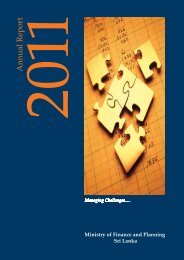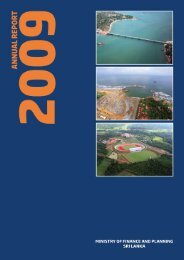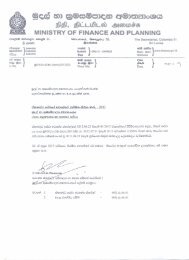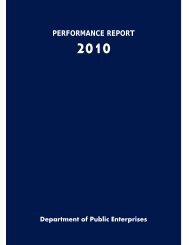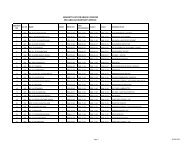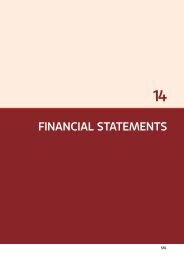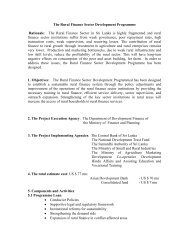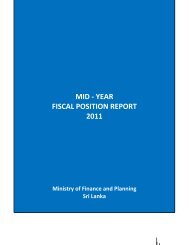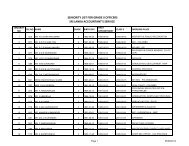Annual Report 2010 - Ministry of Finance and Planning
Annual Report 2010 - Ministry of Finance and Planning
Annual Report 2010 - Ministry of Finance and Planning
Create successful ePaper yourself
Turn your PDF publications into a flip-book with our unique Google optimized e-Paper software.
<strong>Ministry</strong> <strong>of</strong> <strong>Finance</strong> <strong>and</strong> <strong>Planning</strong> Sri Lanka > <strong>Annual</strong> <strong>Report</strong> <strong>2010</strong>to provide Thriposha to all deservingmothers who are 1.1 million <strong>of</strong> populationaccording to the budget proposal<strong>of</strong> 2011. The allocation for ThriposhaProgramme was increased from Rs. 1,100million to Rs. 1,500 million by the Budget2011.Furthermore, soya bean is used toproduce poultry feed in the form<strong>of</strong> Soya Bean Meal. At the momentthis meal is imported incurring aconsiderable cost. Therefore, if thismeal can be developed internallythe dem<strong>and</strong> for soya beans can beimproved while developing the Soyabean meal production locally.Other ProgrammesFacilitatedMaizeThe annual requirement <strong>of</strong> maize is228,000 Mt <strong>of</strong> which 200,000 Mt isconsumed by the livestock sectorwhile 28,000 Mt is used for humanconsumption. A greater share <strong>of</strong>human consumption is utilized for“Thriposha” production. Since the“Thriposha” programme was exp<strong>and</strong>edto cater all the deserving mothers, thedem<strong>and</strong> for maize is rising. Import <strong>of</strong>maize is 27,200 Mt for 2009 <strong>and</strong> 9,571Mt for <strong>2010</strong> showing a decreasingtrend. By 2015 it is targeted to reachthe production level <strong>of</strong> 270,320 Mtwhile decreasing imports gradually.Poultry IndustrySpecial attention was given to boostthe poultry industry <strong>and</strong> regulate theprice <strong>of</strong> poultry products in order tomaintain the supply <strong>of</strong> chicken <strong>and</strong>eggs without any shortage whilemaking available whole chicken at aprice <strong>of</strong> Rs. 320/- per kilogram duringthe festive seasons <strong>of</strong> December,<strong>2010</strong> <strong>and</strong> April, 2011. Production <strong>and</strong>requirement <strong>of</strong> poultry products in2009 <strong>and</strong> <strong>2010</strong> illustrate the shortage(Table 6.11) where Governmentintervened stabilizing the market. Atpresent the industry has grown tomeet the local dem<strong>and</strong> entirely with alittle surplus.Table 6.11 > Production <strong>and</strong> Requirement <strong>of</strong> Chicken <strong>and</strong> Eggs2009 - <strong>2010</strong>Item/ ProductChicken (Mt‘000)Eggs (Mn)YearQuantityProducedSource: Department <strong>of</strong> Animal Production <strong>and</strong> Health.The Government was able to increasethe production <strong>of</strong> chicken during <strong>2010</strong>up to 104,500 Mt which was 99,280 Mtin 2009. Egg production was increasedup to 1,200 million in <strong>2010</strong>, whichwas 1,091 million in 2009. The price<strong>of</strong> chicken <strong>and</strong> eggs were stabilizedduring the festive season <strong>of</strong> December<strong>2010</strong> by closely managing the supply<strong>and</strong> market price fluctuations. Poultryindustry was included under AgroLivestock Development Loan Schemefrom which the poultry industrialistsreceive financial assistance inexp<strong>and</strong>ing their industry.Financial AssistanceSchemesAgro Livestock Development LoanScheme (ALDL)Ensuring self-sufficiency in milkby 2020 <strong>and</strong> retaining the foreignexchange outflow used for imports<strong>of</strong> milk powder within the countryis a prominent area identified bythe “Mahinda Chintana” policyframework. In line with this policy, itwas announced in the 2008 budgetproposals, the development <strong>of</strong> dairyindustry by providing credit facilitiesat concessionary interest rates for theestablishment <strong>of</strong> small <strong>and</strong> mediummilk processing centers, importation<strong>of</strong> milking cows <strong>and</strong> development <strong>of</strong>animal husb<strong>and</strong>ry, which pave theway for the implementation <strong>of</strong> AgroLivestock Development Loan Scheme(ALDL) from 2008. Small farmerborrowers engaged in dairy <strong>and</strong> agroRequirement2009 99.28 111.38<strong>2010</strong> 104.50 112.002009 1,091.00 1,042.00<strong>2010</strong> 1,200.00 1,550.00products, with 6 percent interestsubsidy, <strong>and</strong> the private investors whopurchase liquid milk directly from thesmall farmers, with 2 percent interestsubsidy, are eligible to the loanscheme. The scope <strong>of</strong> the schemewas broadened by including theactivities <strong>of</strong> establishment <strong>of</strong> coolingfacilities <strong>and</strong> block ice manufacturingplants in 2009 <strong>and</strong> activities relatedto poultry farming in <strong>2010</strong>.The bulk <strong>of</strong> the benefits has beengained by the small farmers underthis loan scheme. About 3,418small farmers obtained loans to thevalue <strong>of</strong> Rs. 417 million during <strong>2010</strong>increasing the total number <strong>of</strong> smallfarmer borrowers to 8,851 which is97 percent <strong>of</strong> the total borrowers.The loan disbursement under smallfarmer borrowers is Rs. 933 millionwhich is 67 percent <strong>of</strong> total lo<strong>and</strong>isbursement by December <strong>2010</strong>. Anamount <strong>of</strong> Rs. 63 million has beenreleased to Participatory FinancialInstitutions as interest subsidyby the Government by December<strong>2010</strong> under this programme. Dairyfarmers <strong>of</strong> the milk producingprovinces were able to gainmore benefits compared to otherprovinces as shown in Table 6.12.303



